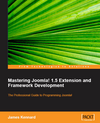作者:Krzysztof Cwalina, Brad Abrams
出版日期:November 1, 2008
出版社:Addison Wesley
页数:480
ISBN:ISBN-10: 0321545613 ISBN-13: 978-0321545619
文件格式:PDF
“ Framework Design Guidelines is oneof those rare books that can be read at different reading levels andcan be useful to different kinds of developers. Regardless of whetheryou want to design an effective object model, improve yourunderstanding of the .NET Framework, borrow from the experience ofsoftware gurus, stay clear of the most common programming mistakes, orjust get an idea of the huge effort that led to the .NET initiative,this book is a must-read.”
–Francesco Balena, The VB Migration PartnerTeam (www.vbmigration.com), Code Architect, Author, and MicrosoftRegional Director, Italy
“ Frameworks are valuable but notoriouslydifficult to construct: your every decision must be geared towardmaking them easy to be used correctly and difficult to be usedincorrectly. This book takes you through a progression ofrecommendations that will eliminate many of those downstream ‘I wishI’d known that earlier’ moments. I wish I’d read it earlier.”
–Paul Besly, Principal Technologist, QA
“ Not since Brooks’ The Mythical Man Month hasthe major software maker of its time produced a book so full ofrelevant advice for the modern software developer. This book has apermanent place on my bookshelf and I consult it frequently.”
–George Byrkit, Senior Software Engineer, Genomic Solutions
“ Updated for the new language features ofthe .NET Framework 3.0 and 3.5, this book continues to be thedefinitive resource for .NET developers and architects who aredesigning class library frameworks. Some of the existing guidelineshave been expanded with new annotations and more detail, and newguidance covering such features as extension methods and nullable typeshas also been included. The guidance will help any developer writeclearer and more understandable code, while the annotations provideinvaluable insight into some of the design decisions that made the .NETFramework what it is today.”
–Scott Dorman, Microsoft MVP and President, Tampa Bay International Association of Software Architects
“ Filled with information useful todevelopers and architects of all levels, this book provides practicalguidelines and expert background information to get behind the rules. Framework Design Guidelines takesthe already published guidelines to a higher level, and it is needed towrite applications that integrate well in the .NET area.”
–Cristof Falk, Software Engineer
“ This book is an absolute must read forall .NET developers. It gives clear ‘do’ and ‘don’t’ guidance on how todesign class libraries for .NET. It also offers insight into the designand creation of .NET that really helps developers understand thereasons why things are the way they are. This information will aiddevelopers designing their own class libraries and will also allow themto take advantage of the .NET class library more effectively.”
–Jeffrey Richter, Author/Trainer/Consultant, Wintellect
“ The second edition of Framework Design Guidelines givesyou new, important insight into designing your own class libraries:Abrams and Cwalina frankly discuss the challenges of adding newfeatures to shipping versions of their products with minimal impact onexisting code. You’ll find great examples of how to create version N+1of your software by learning how the .NET class library team
created versions 2.0, 3.0, and 3.5 of the .NETlibrary. They were able to add generics, WCF, WPF, WF, and LINQ withminimal impact on the existing APIs, even providing capabilities forcustomers wanting to use only some of the new features, while stillmaintaining compatibility with the original library.”
–Bill Wagner, Founder and Consultant, SRT Solutions, author of Effective C# and More Effective C#
“ This book is a must read for all architectsand software developers thinking about frameworks. The book offersinsight into some driving factors behind the design of the .NETFramework. It should be considered mandatory reading for anybody taskedwith creating application frameworks.”
–Peter Winkler, Sr. Software Engineer, Balance Technology Inc.
“An instant classic.”
–From the Foreword by Miguel de Icaza
Framework Design Guidelines, Second Edition,teaches developers the best practices for designing reusable librariesfor the Microsoft .NET Framework. Expanded and updated for .NET 3.5,this new edition focuses on the design issues that directly affect theprogrammability of a class library, specifically its publiclyaccessible APIs.
This book can improve the work of any .NETdeveloper producing code that other developers will use. It includescopious annotations to the guidelines by thirty-five prominentarchitects and practitioners of the .NET Framework, providing a livelydiscussion of the reasons for the guidelines as well as examples ofwhen to break those guidelines.
Microsoft architects Krzysztof Cwalina andBrad Abrams teach framework design from the top down. From theirsignificant combined experience and deep insight, you will learn
The general philosophy and fundamental principles of framework designNaming guidelines for the various parts of a frameworkGuidelines for the design and extending of types and members of typesIssues affecting–and guidelines for ensuring–extensibilityHow (and how not) to design exceptionsGuidelines for–and examples of–common framework design patternsGuidelines in this book are presented in four major forms: Do, Consider, Avoid, and Do not. These directives help focus attention on practices that should always be used, those that should generally be used, those that should rarely be used, and those that should neverbe used. Every guideline includes a discussion of its applicability,and most include a code example to help illuminate the dialogue.
Framework Design Guidelines, Second Edition, is the only definitive source of best practices for managed code API development, direct from the architects themselves.
A companion DVD includes the Designing .NETClass Libraries video series, instructional presentations by theauthors on design guidelines for developing classes and components thatextend the .NET Framework. A sample API specification and other usefulresources and tools are also included.
About the Author
Brad Abrams was a foundingmember of the Common Language Runtime and .NET Framework teams atMicrosoft Corporation. He has been designing parts of the .NETFramework since 1998 and is currently Group Program Manager of the .NETFramework team. Brad started his framework design career building theBase Class Library (BCL) that ships as a core part of the .NETFramework. Brad was also the lead editor on the Common LanguageSpecification (CLS), the .NET Framework Design Guidelines, and thelibraries in the ECMA\ISO CLI Standard. Brad has authored andcoauthored multiple publications, including Programming in the .NET Environment and .NET Framework Standard Library Annotated Reference,Volumes 1 and 2. Brad graduated from North Carolina State Universitywith a B.S. in computer science. You can find his most recent musingson his blog at http://blogs.msdn.com/BradA.
Krzysztof Cwalina is a programmanager on the .NET Framework team at Microsoft. He was a foundingmember of the .NET Framework team and throughout his career hasdesigned many .NET Framework APIs and framework development tools, suchas FxCop. He is currently leading a companywide effort to develop,promote, and apply framework design and architectural guidelines to the.NET Framework. He is also leading the team responsible for deliveringcore .NET Framework APIs. Krzysztof graduated with a B.S. and an M.S.in computer science from the University of Iowa. You can find his blogat http://blogs.msdn.com/kcwalina.





 评论 (2)
评论 (2) 